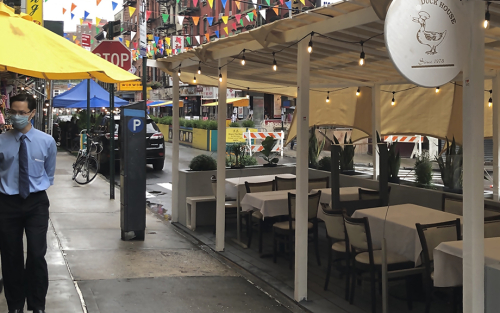Remote Work Is Sticking

When the pandemic hit in early 2020, many businesses quickly and significantly expanded opportunities for their employees to work from home, resulting in a large increase in the share of work being done remotely. Now, more than two years later, how much work is being done from home? In this post, we update our analysis from last year on the extent of remote work in the region. As has been found by others, we find that some of the increase in remote work that began early in the pandemic is sticking. According to firms responding to our August regional business surveys, about 20 percent of all service work and 7 percent of manufacturing work is now being conducted remotely, well above shares before the pandemic, and firms expect little change in these shares a year from now. While responses were mixed, slightly more firms indicated that remote working had reduced rather than increased productivity. Interestingly, however, the rise in remote work has not led to widespread reductions in the amount of workspace being utilized by businesses in the region.
Do Businesses in the Region Expect High Inflation to Persist?

As the economy continues to recover from the pandemic, a combination of strong demand, severe supply disruptions, widespread labor shortages, and surging energy prices has contributed to a rapid increase in inflation. Indeed, the inflation rate, as measured by the Consumer Price Index (CPI), has exceeded 8 percent over the past year, the fastest pace of price increase since the early 1980s. If businesses and consumers expect inflation to be high in the future because it is elevated today, they may change their behavior accordingly, which can make inflation even more persistent. In other words, expectations about the path of future inflation can affect how current inflation will actually evolve. In particular, among businesses, expectations about future inflation can shape how they set wages and prices. Our May regional business surveys asked firms what they expected inflation to be one year, three years, and five years from now. Responses indicate that while businesses, like consumers, expect high inflation to continue over the next year, such elevated levels of inflation are not expected to persist over longer time horizons.
The Omicron Wave Stalled Growth and Led to High Absenteeism in the Region

Even before the start of the new year, businesses in the tri-state region were hampered by supply disruptions, rising input costs, and difficulty finding adequate staff. On top of these challenges, the Omicron wave dealt another setback to the regional economy. With infections running high, many businesses were forced to deal with a combination of reduced demand from customers and renewed absenteeism among workers. Indeed, our regional business surveys indicate that economic growth stalled in early 2022 as firms continued to struggle to find workers. Moreover, employee absenteeism was reported to be nearly three times its normal level. While the path of recovery remains highly uncertain, firms generally expect conditions to improve in the months ahead and many are still adding or planning to add staff.
Severe Supply Disruptions Are Impeding Business Activity in the Region

As the economy continues to recover from the pandemic recession, many businesses are struggling to keep up with surging demand amid widespread supply shortages and delays. While a rare phenomenon before the pandemic, supply chain disruptions have become increasingly common, with transportation of goods becoming especially tricky due to myriad issues such as clogged ports and difficulty finding truck drivers. Indeed, such supply disruptions are expected to continue into next year. Our October regional business surveys asked firms to what extent, if any, they are being affected by supply problems and what measures they have taken in response. Difficulty obtaining supplies was nearly universal among survey respondents, affecting about 80 percent of service firms and 95 percent of manufacturers. A large share of businesses in the region have responded to the disruptions by increasing their selling prices and scaling back their operations.
The Future of Remote Work in the Region

The coronavirus pandemic abruptly changed the way we work, in meaningful and potentially lasting ways. While working from home represented a small share of work before the pandemic, such arrangements became unexpectedly widespread once the pandemic struck. With the pandemic now being brought under control and conditions improving, workers have begun to return to the office. But just how much remote work will persist in the new normal? The New York Fed’s June regional business surveys asked firms about the extent of remote working before, during, and after the pandemic. Results indicate that before the pandemic, the average firm in the region conducted just a small share of its work remotely, a figure that currently stands at around a third among service firms but well below 10 percent among manufacturers. Once the pandemic is fully behind us, service firms expect double the amount of remote work than before the pandemic, though that figure is less than the share being done currently, while manufacturers expect the amount of remote work to return to where it was before the pandemic.
April Regional Service‑Sector Survey Points to A Long‑Awaited Rebound

While the manufacturing sector typically drives recessions and recoveries more than the service sector, the opposite has been true during the pandemic recession. Finally this month, the Federal Reserve Bank of New York’s April business surveys point to a solid increase in service sector activity as well as continued strength in manufacturing activity in the New York-Northern New Jersey region, marking the first signs of widespread growth since the pandemic began. While manufacturing activity had been increasing through much of the pandemic, service sector activity had declined for thirteen straight months before finally increasing at its strongest pace in years in our April survey. About half of service sector firms said their revenues were currently at or above normal levels, as did two-thirds of manufacturers. All in all, regional firms expressed widespread optimism that conditions would improve in the months ahead.
February Regional Business Surveys Find Widespread Supply Disruptions

Business activity increased in the region’s manufacturing sector in recent weeks but continued to decline in the region’s service sector, continuing a divergent trend seen over the past several months, according to the Federal Reserve Bank of New York’s February regional business surveys. Looking ahead, however, businesses expressed widespread optimism about the near-term outlook, with service firms increasingly confident that the business climate will be better in six months. The surveys also found that supply disruptions were widespread, with manufacturing firms reporting longer delivery times and rising input costs, a likely consequence of such disruptions. Many firms also noted that minimum wage hikes implemented in January in both New York and New Jersey had affected their employment or compensation decisions.
The Regional Economy during the Pandemic

The New York-Northern New Jersey region experienced an unprecedented downturn earlier this year, one more severe than that of the nation, and the region is still struggling to make up the ground that was lost. That is the key takeaway at an economic press briefing held today by the New York Fed examining economic conditions during the pandemic in the Federal Reserve’s Second District. Despite the substantial recovery so far, business activity, consumer spending, and employment are all still well below pre-pandemic levels in much of the region, and fiscal pressures are mounting for state and local governments. Importantly, job losses among lower-income workers and people of color have been particularly consequential. The pace of recovery was already slowing in the region before the most recent surge in coronavirus cases, and we are now seeing signs of renewed weakening as we enter the winter.
Tracking the Spread of COVID‑19 in the Region
The New York Fed today unveiled a set of charts that track COVID-19 cases in the Federal Reserve’s Second District, which includes New York, Northern New Jersey, Fairfield County Connecticut, Puerto Rico, and the U.S. Virgin Islands. These charts, available in the Indicators section of our Regional Economy webpage, are updated daily with the latest data on confirmed COVID-19 cases from The New York Times, which compiles information from state and local health agencies. Case counts are measured as the seven-day average of new reported daily cases and are presented on a per capita basis to allow comparisons to the nation and between communities in the region. Recent data indicate that after spiking to extraordinary levels in April, new cases have remained relatively low and stable in and around New York City, and in upstate New York. By contrast, cases have been trending higher in Puerto Rico and the U.S. Virgin Islands since mid-July.
Finally, Some Signs of Improvement in the Regional Economy

The Federal Reserve Bank of New York’s June business surveys show some signs of improvement in the regional economy. Following two months of unprecedented decline due to the coronavirus pandemic, indicators of business activity point to a slower pace of contraction in the service sector and signs of a rebound in the manufacturing sector. Even more encouraging, as the regional economy has begun to reopen, many businesses have started to recall workers who were laid off or put on furlough since the start of the pandemic. Some have even hired new workers. Moreover, businesses expect to recall even more workers over the next month. Looking ahead, firms have become increasingly optimistic that conditions will improve in the coming months.














 RSS Feed
RSS Feed Follow Liberty Street Economics
Follow Liberty Street Economics